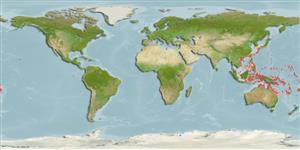>
Blenniiformes (Blennies) >
Tripterygiidae (Triplefin blennies) > Tripterygiinae
Etymology: Helcogramma: Greek, helkos, -eos, -ous = ulcer, sore + Greek, gramma = letter, mark (Ref. 45335).
More on author: Bleeker.
Environment: milieu / climate zone / depth range / distribution range
Ecologia
marino associati a barriera corallina; distribuzione batimetrica 0 - 6 m (Ref. 58018). Tropical
Western Pacific: East Andaman Sea (Thailand), Malaysia (Tioman Island), Indonesia (Belitung, Komodo, Halmahera, and Banda Sea), Philippines (Luzon), Papua New Guinea (wewak), Solomon Islands, Vanuatu, and Taiwan.
Size / Peso / Age
Maturity: Lm ? range ? - ? cm
Max length : 4.5 cm SL maschio/sesso non determinato; (Ref. 559)
Short description
Morfologia | Morfometria
Spine dorsali (totale): 16 - 18; Raggi dorsali molli (totale): 8-11; Spine anali 1; Raggi anali molli: 16 - 19. Trunk without longitudinal stripes; symphyseal dentary pores 3 or more; lateral line with fewer than 25 scales; anal fin with fewer than 19 rays; male with bluish white stripe from corner of jaw onto preopercle (Ref. 94457). Additional description: Dorsal fin III + XIII-XV + 8-11; anal fin I, 16-19; pectoral rays 16-17; pelvic fin I,2. Lateral line continuous, pored scales 21-29; head and narrow strip on upper back scaleless, nape with only a few scales. Mandibular sensory pores 3-8 + 3-9 + 3-8 (usually 3+3+3). Male greyish green, head ventrally black, cheek with blue horizontal stripe; body vertical bars H-shaped, brownish; zone between pectoral fin and operculum greenish grey. Female overall translucent, head marks brown, H-bars faint, fins translucent (Ref. 90102).
Adults inhabit coral and rocky bottoms at depths of 6 m and shallower (Ref. 90102). Eggs are hemispherical and covered with numerous sticky threads that anchor them in the algae on the nesting sites (Ref. 240). Larvae are planktonic which occur primarily in shallow, nearshore waters (Ref. 94114).
Life cycle and mating behavior
Maturità | Riproduzione | Deposizione | Uova | Fecundity | Larve
Masuda, H., K. Amaoka, C. Araga, T. Uyeno and T. Yoshino, 1984. The fishes of the Japanese Archipelago. Vol. 1. Tokai University Press, Tokyo, Japan. 437 p. (text). (Ref. 559)
IUCN Red List Status (Ref. 130435)
Threat to humans
Harmless
Human uses
Informazioni ulteriori
Nomi ComuniSinonimiMetabolismoPredatoriEcotossicologiaRiproduzioneMaturitàDeposizioneSpawning aggregationFecundityUovaEgg development
Age/SizeAccrescimentoLength-weightLength-lengthLength-frequenciesMorfometriaMorfologiaLarveDinamica popolazioni larvaliReclutamentoAbbondanzaBRUVS
BibliografiaAcquacolturaProfilo di acquacolturaVarietàGeneticaElectrophoresesEreditarietàMalattieElaborazioneNutrientsMass conversion
CollaboratoriImmaginiStamps, Coins Misc.SuoniCiguateraVelocitàModalità di nuotoArea branchialeOtolithsCervelliVista
Strumenti
Special reports
Download XML
Fonti Internet
Estimates based on models
Preferred temperature (Ref.
123201): 24.7 - 29.3, mean 28.6 °C (based on 1714 cells).
Phylogenetic diversity index (Ref.
82804): PD
50 = 0.5000 [Uniqueness, from 0.5 = low to 2.0 = high].
Bayesian length-weight: a=0.01000 (0.00244 - 0.04107), b=3.04 (2.81 - 3.27), in cm total length, based on all LWR estimates for this body shape (Ref.
93245).
Trophic level (Ref.
69278): 3.1 ±0.3 se; based on size and trophs of closest relatives
Resilienza (Ref.
120179): Alto, tempo minimo di raddoppiamento della popolazione meno di 15 mesi (Preliminary K or Fecundity.).
Fishing Vulnerability (Ref.
59153): Low vulnerability (10 of 100).
